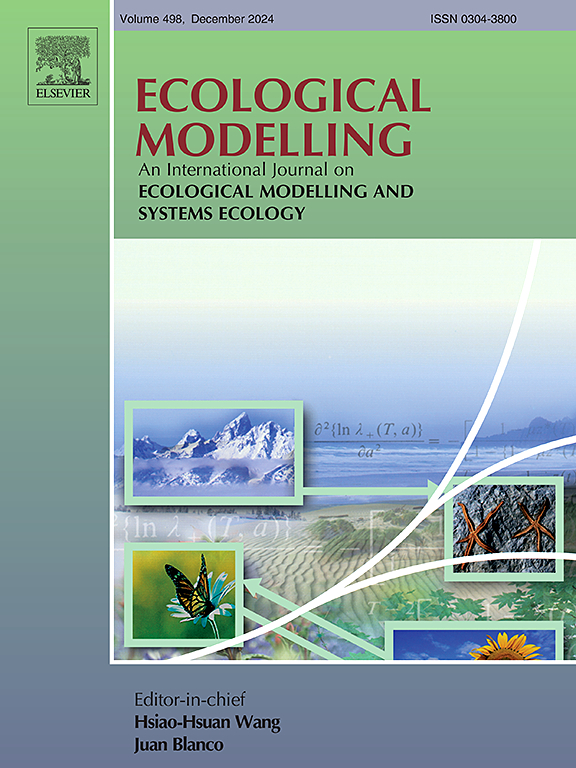基于过程建模和卫星图像的时间序列水下植被构建
IF 2.6
3区 环境科学与生态学
Q2 ECOLOGY
引用次数: 0
摘要
水下水生植被(SAV)在湖泊生态系统健康中起着至关重要的作用。然而,由于时间序列数据有限,量化SAV生物量的时空格局仍然具有挑战性。为了解决这一挑战,我们将基于过程的SAV动态模型与基于卫星的SAV生物量估算模型相结合,构建了中国最大的淡水湖鄱阳湖的子湖湛北湖的SAV时间序列数据集。综合模型有效捕获了SAV生物量动态,与实测数据相比,模型性能R2=0.60, RMSE=0.24 kg/m2。结果表明,在洪泛区附近,SAV更为丰富。SAV生物量从0.76 kg/m2(2021年)显著下降到0.19 kg/m2(2022年),主要原因是极端干旱导致年平均水位从14.1 m(2021年)下降到13.4 m(2022年)。水位是SAV生物量最敏感的驱动因素,最佳水位下温度对SAV生物量也有显著影响。我们的情景模拟显示,全球变暖可以促进SAV的生长,而营养物质的影响最小。与之前发表的原位测量结果相比,该综合模型为研究SAV动力学提供了一种成本效益高、分辨率高的方法,在其他湖泊中具有潜在的应用前景。本文章由计算机程序翻译,如有差异,请以英文原文为准。

Constructing time-series submerged aquatic vegetation by integrating process-based modeling and satellite images
Submerged aquatic vegetation (SAV) plays a critical role in lake ecosystem health. However, quantifying the spatiotemporal patterns of SAV biomass remains challenging due to limited time-series data. To address this challenge, we integrated a process-based SAV dynamic model with a satellite-based SAV biomass estimation model to construct a time-series SAV dataset for Lake Zhanbei, a sub-lake within China's largest freshwater lake, Lake Poyang. The integrated model effectively captured SAV biomass dynamics, with model performance of R2=0.60 and RMSE=0.24 kg/m2 compared to measured data. Results showed that SAV was more abundant near floodplain areas. A significant decline of SAV biomass was observed from 0.76 kg/m2 (2021) to 0.19 kg/m2 (2022), primarily due to a drop in the annual average water level from 14.1 m (2021) to 13.4 m (2022) caused by extreme drought. Water level was the most sensitive driver of SAV biomass, while temperature also had a notable impact under optimal water levels. Our scenario simulations revealed that global warming could enhance SAV growth, while nutrients had minimal effects. Compared with in-situ measurements from previous publications, the integrated model offers a cost-effective and high-resolution approach to study SAV dynamics, with potential applications in other lakes.
求助全文
通过发布文献求助,成功后即可免费获取论文全文。
去求助
来源期刊

Ecological Modelling
环境科学-生态学
CiteScore
5.60
自引率
6.50%
发文量
259
审稿时长
69 days
期刊介绍:
The journal is concerned with the use of mathematical models and systems analysis for the description of ecological processes and for the sustainable management of resources. Human activity and well-being are dependent on and integrated with the functioning of ecosystems and the services they provide. We aim to understand these basic ecosystem functions using mathematical and conceptual modelling, systems analysis, thermodynamics, computer simulations, and ecological theory. This leads to a preference for process-based models embedded in theory with explicit causative agents as opposed to strictly statistical or correlative descriptions. These modelling methods can be applied to a wide spectrum of issues ranging from basic ecology to human ecology to socio-ecological systems. The journal welcomes research articles, short communications, review articles, letters to the editor, book reviews, and other communications. The journal also supports the activities of the [International Society of Ecological Modelling (ISEM)](http://www.isemna.org/).
 求助内容:
求助内容: 应助结果提醒方式:
应助结果提醒方式:


